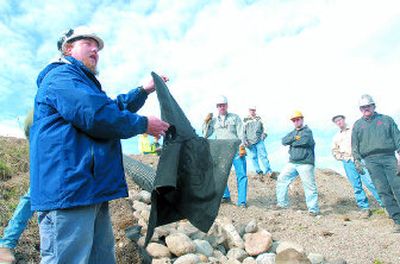Builders learn flow control

Smothered trout spawning beds, muddied lake water and bays filled with silt are evidence of a dirty secret behind North Idaho’s building boom: Erosion.
A new class for developers and contractors has been launched to help curb erosion from construction sites.
“They want to do the right thing, it’s just a matter of knowing how,” said Rebecca Stevens, with the Coeur d’Alene Tribe’s Lake Management Program.
Last week, Stevens and other experts held a class in Coeur d’Alene for 25 building professionals. Similar sessions are being held across North Idaho this spring thanks to a federal grant.
Tom Freeman, owner of CDF Landscape, of Coeur d’Alene, helped organize the voluntary classes. He spent Friday in a gravel pit near Rathdrum showing the students everything from proper silt fence installation to the fine points of anchoring a drainage culvert.
Freeman, a landscape architect and certified erosion control expert, earns a living by helping to control erosion. He admitted the classes could cut into his business, but he said something needs to be done.
“It upsets me when I drive by a site and it’s not maintained,” Freeman said. “It upsets me as a taxpayer because we have to pay to clean it up.”
Not only are clean sites good for the environment, they’re also good advertising for potential clients, Freeman said. Apart from that, “it’s just the right thing to do,” he said.
County ordinances and federal laws are aimed at keeping dirt out of waterways, but government inspectors have struggled to keep up with the pace of building in North Idaho.
During a recent boat tour around Lake Coeur d’Alene, state and tribal officials spotted lots of silt fences and erosion control devices at lakefront home construction sites, but the majority of devices appeared to be installed incorrectly, said Glen Rothrock, with the Idaho Department of Environmental Quality. The silt fences, for example, were not anchored and did nothing to trap muddy water flowing off sites.
The tour also revealed many home sites where the frontage had been scraped clean of native vegetation, Rothrock said. This violates a county law requiring a 25-foot-wide buffer strip on the lakeshore.
Dirt and mud flowing off construction sites – even those far from water – have blanketed streams with silt and eventually foul lakes, Rothrock said. The sediment is laden with phosphorus, which is believed to help spark a chemical reaction at the bottom of the lake.
Millions of tons of heavy metal sediment that washed down from the Silver Valley now rest at the bottom of Lake Couer d’Alene. The phosphorus robs oxygen from the lake, which causes some of these heavy metals to dissolve and kill aquatic life, Rothrock said.
Studies are being conducted to determine the extent the problem, but Rothrock said large swaths of the lake bottom are already devoid of life.
The cities of Coeur d’Alene and Post Falls – and eventually Spokane – are spending tens of millions of dollars on sewage treatment plant upgrades to help reduce the amount of phosphorus in wastewater discharged into the Spokane River. Preventing erosion is another way of dealing with the problem, Rothrock said.
The first three stormwater erosion education courses offered in North Idaho – and all of Idaho, for that matter – had waiting lists. Plans are under way to offer the classes again in fall, Rothrock said.
One of those attending last week’s class in Coeur d’Alene and Rathdrum was Joe Krizensky, a superintendent at Sackett Excavation, of Priest Lake. He intends to share his training with his workers.
“We just want to be proactive,” he said, after seeing a demonstration on proper silt fence installation. “Customers don’t want a company that’s not doing the right thing.”